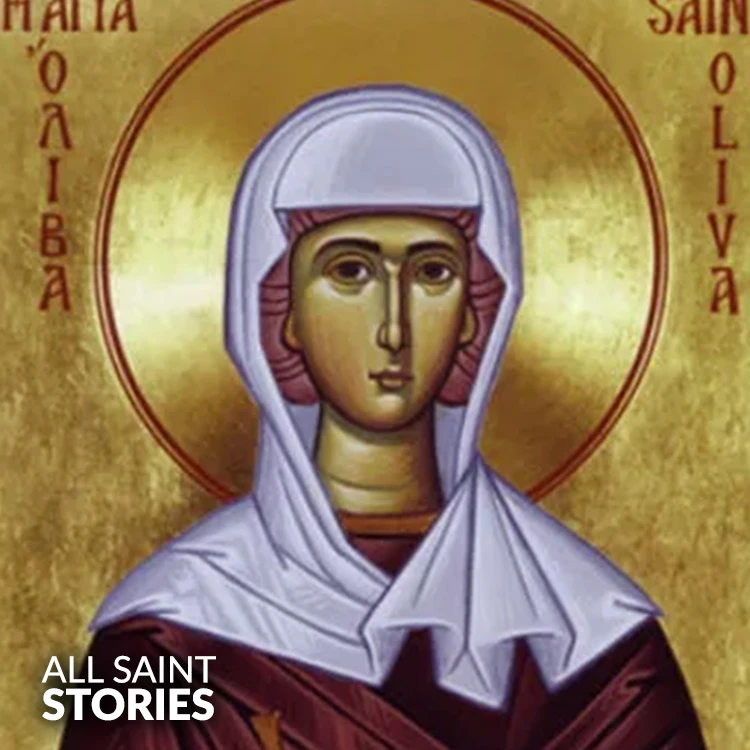O glorious St. Olivia, faithful virgin and martyr, intercede for us in our trials. Help us to stand firm in our faith, as you did, with courage and love. Through your holy witness, may we find strength in adversity and trust in God’s mercy. Amen.
ST. OLIVIA OF PALERMO
ST. OLIVIA OF PALERMO

St. Olivia of Palermo was a Christian virgin and martyr from Sicily, revered for her steadfast faith and beauty. Despite uncertainty about her historical date, her legend as a converter of souls and symbol of Christian resistance remains powerful, especially in Palermo where she is a patron saint.
St. Olivia of Palermo is a revered Christian saint whose story has been passed down through centuries, blending historical fragments with elements of legend and devotion. Believed to have been born in the city of Palermo in Sicily, she is often dated to either the 5th or the 9th century, depending on the source. Some traditions connect her life to the time of the Vandal invasions of North Africa in the 5th century, while others place her during the Muslim rule of Sicily in the 9th century. Despite this historical ambiguity, her significance as a symbol of Christian piety and resilience has remained steadfast, particularly in Sicily.
According to the most popular legends, Olivia was born into a noble family and was distinguished from a young age by her devout faith and striking beauty. As a Christian in a time of religious persecution, she faced great personal risk. The accounts suggest that she was either exiled or captured due to her unwavering commitment to Christianity. In exile, believed to be in Tunis or another part of North Africa, she dedicated herself to spreading the Christian message. Her virtue and miracles are said to have converted many to the faith, attracting the attention of local authorities.
As the legend goes, Olivia was subjected to numerous tortures for refusing to renounce her Christian beliefs. The details vary, but commonly include her being whipped, imprisoned, and eventually beheaded. Some versions describe wild beasts refusing to harm her or divine interventions protecting her from death, underlining her sanctity in the narrative tradition. Her martyrdom solidified her place as a saint in the hearts of believers, even before any formal canonization process existed.
Veneration of St. Olivia grew particularly in Palermo, where she became one of the city’s patron saints. Churches were built in her honor, including the Church of Santa Oliva. Her feast day is celebrated on June 10. Her image has often been depicted in Sicilian religious art, frequently showing her holding a cross, a palm of martyrdom, or wearing noble garments. During the period of Muslim rule in Sicily, stories of her miraculous resistance to forced conversion likely served as inspiration to local Christians trying to maintain their identity and faith.
Interestingly, there is also evidence that her legend may have developed or expanded significantly during the Middle Ages, possibly shaped by the Christian resistance to Islamic rule or the desire to assert religious heritage. This blending of hagiography and cultural history makes St. Olivia not only a religious figure but also a cultural one, representing both faith and resistance.
Though no specific relics or confirmed burial site exists, and her historical details remain debated, the spiritual legacy of St. Olivia of Palermo endures. Her name continues to inspire devotion, particularly in southern Italy and parts of the Mediterranean. She remains an emblem of spiritual purity, missionary zeal, and enduring strength in the face of persecution.
Video Not Found
No images uploaded for this saint yet.
The information on this website is compiled from various trusted sources. While we aim for accuracy, some details may be incomplete or contain discrepancies.
If you notice any errors or have additional information about this saint, please use the form on the left to share your suggestions. Your input helps us improve and maintain reliable content for everyone.
All submissions are reviewed carefully, and your personal details will remain confidential. Thank you for contributing to the accuracy and value of this resource.
Credits & Acknowledgments
- Anudina Visudhar (Malayalam) – Life of Saints for Everyday
by Msgr. Thomas Moothedan, M.A., D.D. - Saint Companions for Each Day
by A. J. M. Mausolfe & J. K. Mausolfe - US Catholic (Faith in Real Life) – Informational articles
- Wikipedia – General reference content and images
- Anastpaul.com – Saint images and reflections
- Pravachaka Sabdam (Malayalam) – Saint-related content and insights
We sincerely thank these authors and platforms for their valuable contributions. If we have unintentionally missed any attribution, please notify us, and we will make the correction promptly.
If you have any suggestion about ST. OLIVIA OF PALERMO
Your suggestion will help improve the information about this saint. Your details will not be disclosed anywhere.
© 2025 Copyright @ www.allsaintstories.com

 English
English
 Italian
Italian
 French
French
 Spanish
Spanish
 Malayalam
Malayalam
 Russian
Russian
 Korean
Korean
 Sinhala
Sinhala
 Japanese
Japanese
 Arabic
Arabic
 Portuguese
Portuguese
 Bantu
Bantu
 Greek
Greek
 German
German
 Dutch
Dutch
 Filipino
Filipino